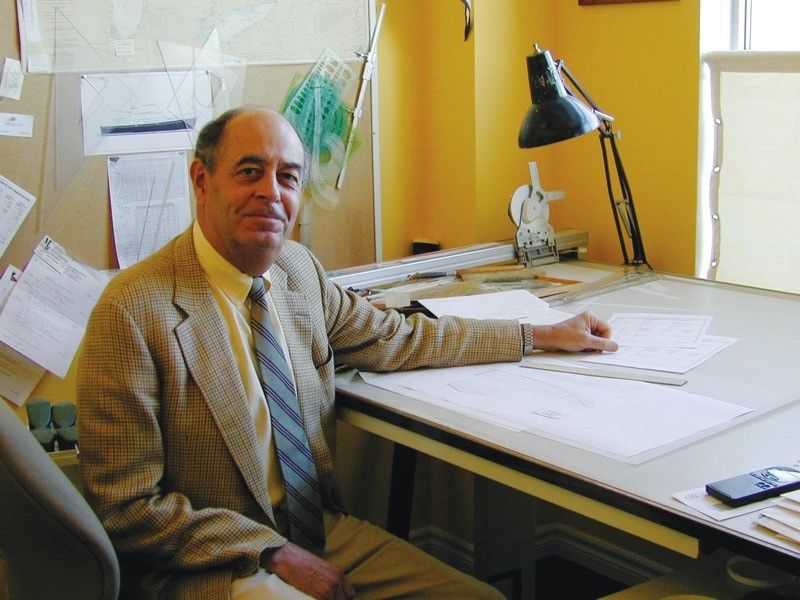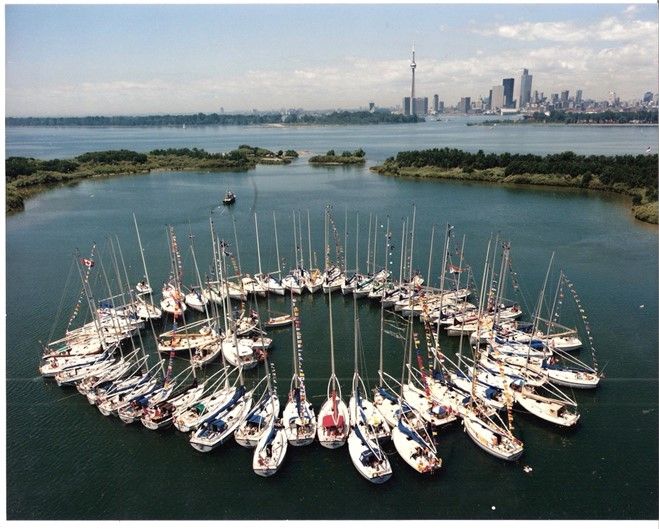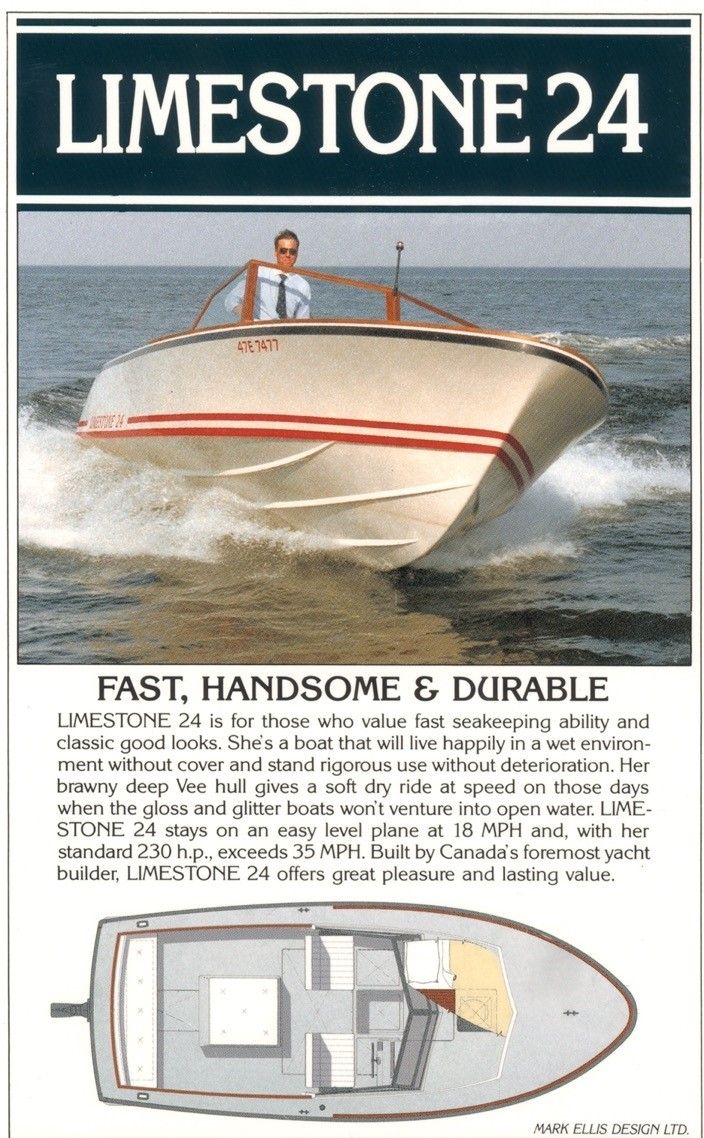When I saw Susie Smith’s “Return of the LIMESTONE” article in the January edition of TILife, I jumped on it. The Limestone has always seemed to be just a boat slip away throughout my life. My next-door neighbour in Toronto had one. When I bought Wood Isle in the Lake Fleet Group in 1987, three of my shore-side, dock-neighbours at the old Brennan’s Marine had Limestones. When the owner of Dumfounder, the big island next to me, first drifted up to my dock to say hello, he, too, was in a Limestone and he said something like, “Hi, I’m Mark from there” (pointing at Dumfounder). And at that moment, my 30-year friendship with Mark Ellis, long-time River Rat, esteemed yacht designer, and father of the Limestone began.
To know the Limestone, you need to know Mark Ellis, and his amazing boat-building Canadian story.

Mark was born in Watertown, in northern New York State, where his grandfather had started “The Globe Store”. Mark’s father continued the business, and his business acumen and interest in sports and travel, would impact Mark greatly.
A year before Mark’s birth in 1945, an island in the Thousand Islands became available for purchase; the result was that young Mark spent most of his formative years on the River. The River community was hands-on “let’s-do-it” minded and ensured all opportunities were pursued. A neighbour loaned Mark a 1930’s lapstrake, frostbite dinghy when he was 11, so that he could learn to sail solo. The Axeman Island sailing regattas were only a jibe and a tack away. So over the years, Mark made many River friends and ultimately met his wife Barbara, who hails from the Axeman dynasty.
“Much of my idle time as a youngster was spent drawing boats and making models. In 1958, when the America’s Cup was first sailed in 12 Meters, I was immersed in anything I could find about those boats. I knew them by their sail numbers, builders, designers and famous crews. In the eighth grade (1959) on a visit to New York City and having written (boat designers) Sparkman & Stephens a request, I was able go to the NYYC Model Room. WOW! It is no surprise that, when ninth grade students were required to write a “Career Book”, mine was on yacht design. The experiences of pleasure and chores associated with cottages and boats were my delight and instilled much that was of practical importance in life.”
Post-war schools’ offerings were not necessarily aligned with young imaginations. Pre-set curricula meant he couldn’t take practical courses and had to become a self-taught draftsman. In high school, he was accepted into a Yachting magazine contest to pick a new 3 Man Keelboat design. At the same time, innovative powerboat designs were appearing on the River and those got his attention as well. He needed to make a school choice and “. . . since naval architecture programs of the day contained very little on sailboats, or even pleasure craft, which, of course, were my major interest, I opted for a liberal arts school”.
At school in Boston, he looked for a part time job in a boatyard. He was prepared to sweep the shop, pencil a design or make a client call. “Pitch in and do whatever to be part of the boat business.“
He was hired by C.R. Hunt Associates as a part-timer in a 3-man shop. Working in the Hunt office was the ultimate job. Ray Hunt had introduced the first ‘deep V hulls’ Mark had seen on the River and now Mark was there at the birthplace of Bertram and Moppie, revolutionary boat designs. After his liberal Arts freshman-year, he wisely took a year off to work for Master Boat Builder Paul Cobel, at Minneford Yacht Yard, City Island, New York. Here he enjoyed a variety of jobs including “freezing my butt off while scraping paint and tar from the inside of a fuel barge in January!” But if that is what it took to connect with these experts in building revered, big-plank, wooden boats . . . Mark was in.
As it happened, this was not the only time Mark would experience the special bond between people and their boats. His open, friendly, and competent approach led him to meet and work with the Who’s Who of yacht brands, their owners and skippers. Ted Hood, the racer and sailmaker, eminent New York naval-architect Philip Rhodes, John Deknatel of Hunt, who not only gave Mark his part-time job, but was influential in enabling Mark’s ongoing learning about the Deep-V hulls that he first saw on the River.
In 1970, Canada was world-class in innovation, and word had spread quickly in the tight-knit boating world. At just 25 years of age, Mark received an offer from George Cuthbertson of the newly amalgamated C&C Yachts in Port Credit, Ontario, to join them as a designer. This was a major opportunity that enabled Mark, the cross-border River Rat, to move to Canada.
George Cuthbertson & George Cassian (C&C) had joined with custom builder Bruckmann, and two production builders, Belleville Marine, and Hinterhoeller to form C&C Yachts. These were individuals whose names and reputations were well known to serious boaters. Their 39-foot custom sloop ‘Red Jacket’ was the first non-US boat to win the Southern Ocean Race Circuit (SORC) and she lives now at the Maritime Museum in Kingston.
C&C was at the top of the ocean racing universe in those days and building for the Great Lakes. The quality of boats (ideas and construction) was exceptional, and under the wing of designer George Cassian, Mark was in his element drawing spar details and deck fittings for the first C&C 61 ‘Sorcery’, a big, light, flush-decked racer. The work was good, but Mark remembered his father’s business teachings from years earlier. As a C&C shareholder, he made his views known that there were areas in which C&C as a corporation was making some basic business errors. His departure from C&C followed and Mark had to consider his future.
In 1975, in Oakville at age 30, Mark started Mark Ellis Design (MED), simply “based on my intuitive sense of design and aesthetics and practical knowledge derived from working with generous mentors”.
His first design project was the Aurora 40 and it impressed boatbuilding genius George Hinterhoeller (recently ex C&C) enough to start a new firm to build Mark’s following design, the Niagara 35. “This was a big deal that resulted in Hinterhoeller Yachts building nearly 1500 Mark Ellis designed boats in the following 17 years.”
With George Hinterhoeller locked into building his designs, Mark was again both ‘afloat and well grounded’.
“The society that I had been introduced to, in Oakville and Toronto, included many nationally known figures, sailing and otherwise, and I was, and remain astounded at how forthcoming and supportive, they were.”
He joined the Royal Canadian Yacht Club (RCYC) and there he met and sailed with people who would become lifelong friends.
Gordon Fisher, who was President of Southam Media, introduced Mark to his friend Fred Eaton, head of Canada’s major retailing chain “Eaton’s”. They all shared a passion for pushing the envelope, succeeding in design execution and winning. Remember that Canada at that time ‘punched well above its weight class’ in innovative thinking and doing. The Avro Arrow and its untimely political demise was still on Canadian minds and lips.
“For the boy from upstate New York this was amazing. I was always treated as an equal amongst these pillars of Canadian society. This speaks so well to the quality of the people, friendships, and life in Canada. I don’t believe this would have been possible in the US where I would have been a smaller fish in a bigger pond.”
In 1977, Gordon Fisher asked Mark about an idea he had for a new 30’ catboat design. Before pencil touched paper, he called it ‘Nonsuch’ and said it was to have a fin keel, spade rudder, and unstayed mast. He saw ‘Nonsuch’ as a boat of reasonable size that could be cruised by a family or raced as a single-handed one-design class.
“It never occurred to me that I didn’t have any background in designing such a boat”, says Mark, “and that no example of such a craft existed, save for the Finn dinghy or Laser. Looking back on the risk involved, I’m surprised that it didn’t concern me that we went directly from my drawings to building molds and boats.”
“George Hinterhoeller was the builder of choice, but George didn’t believe that there was a market for such a different boat, even if it did perform as hoped. Gordon Fisher wanted his idea built though, and put up the funds for the molds and guaranteed the sale of the first four boats. Essentially, he bribed George to build them!” says Mark. The good news was George Fisher, Mark Ellis, and Fred Eaton would now all have identical boats to sail and race. The great news was that Nonsuch worked really well “right out of the box and did well in local racing”. As of today, 975 ‘Nonsuch’ have been built.

Fred Eaton had an island cottage in Georgian Bay and one day over libations, he asked Mark to design a powerboat for use on Georgian Bay. Fred felt that few Canadian designers and builders were providing next-generation Deep-V hull designs. In his book, “Between Stone and Stars” Fred tells the 1985 Limestone story as only the Limestone’s enabler could.
“One sail-past at RCYC, I was with Mark on his own Nonsuch. We had a drink on the boat and then headed to a restaurant where there were additional drinks. I had just sold my 28 foot Bertram and was telling Mark what a hell of a boat that was. It was such a hell of a boat that I was regretting having sold it. There wasn't anything afloat on the Canadian power boat market that could handle the big water of Georgian Bay, with speed safety and rugged utility. Canadian power boat builders were quite literally copying popular American models by Bayliner and Sea Ray that were not up to the task. ‘Oh … I could design one of those for you!’ Mark said. We were several sheets to the wind by then, but Mark really could. On the Monday after sail-past, I phoned Mark to assure him it had not just been the drinks talking. ‘I was serious about wanting you to design the power boat,’ I said. ‘So was I,’ Mark replied. The result was a 24-foot powerboat with an inboard/ outboard engine, a generous cockpit, and a small V berth. Mark Ellis looked at a chart of Georgian Bay, saw the Limestone islands, a lonely archipelago off Parry Sound, and named the boat the Limestone.” (Fred Eaton)
Once again George Hinterhoeller was put to work.
“George was pushed into production by an owner who made it too financially tempting to say no,” says Mark. By the time Limestone was in full production, Hinterhoeller was running five lines, full tilt, producing Mark Ellis designs for sailors, weekenders, cottagers, and marine police. They really were . . . everywhere.
“Those were great days,” says Mark, “but 5 years later, a diminishing boat market forced Hinterhoeller Yachts into receivership”.
Once more time, the luck of being in the company of other boat lovers, at the right time, presented itself. Mark was living in Oakville when the Medeiros family introduced themselves. They were new generation Canadians, originally Portuguese farmers who had emigrated from the Azores. They had excellent craft-skills working with fiberglass and wood and asked Mark to draw them a 20’ powerboat, which they would build. Mark drew the Medeiros 20, which Medeiros built and launched in 1985. With Hinterhoeller’s demise, Mark then engaged Medeiros to take on his designs, inclusive of the Tadenac 22 and Limestone lines. Mark retains ownership of his designs and all models are still being produced.
Mark says, “ I’m glad to see the Limestone evolving further and to be myself actively involved in the updated designs. My life has been rewarded by the exceptional and generous people I have met over the years and the wonderful Canadian experience I have enjoyed. It has played out well and I certainly have no regrets!”

Additional Update:
On February 20, 2021, Fred Eaton passed after a lengthy illness. Mark spoke with his friend of 50 years, just days before his death and they shared old stories … as sailors will do. They remembered a first Limestone ad where Fred piloted his Limestone directly at the camera. Seeing the ad Fred had chuckled …“It says, ‘Fast, Handsome and Durable’. Shouldn’t you be talking about the boat?”
Their laughter and their memories remain.
By Doug McLellan
Posted in: Volume 16, Issue 3, March 2021, People, Places, History, Sports
Please click here if you are unable to post your comment.
